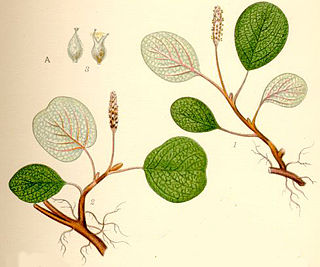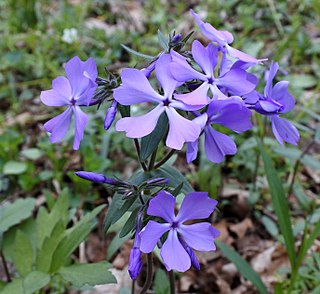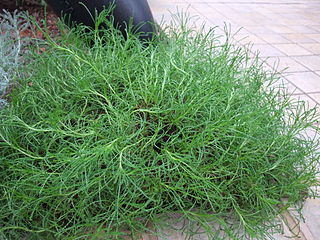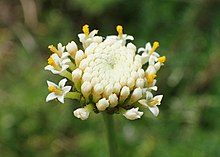
Lavandula stoechas, the Spanish lavender or topped lavender (U.S.) or French lavender (U.K.), is a species of flowering plant in the family Lamiaceae, occurring natively in several Mediterranean countries, including France, Spain, Portugal, Italy, Turkey and Greece.

Grevillea rosmarinifolia, commonly known as rosemary grevillea, is a species of flowering plant in the family Proteaceae and is endemic to south-eastern continental Australia and naturalised in other parts of the country. It is usually an erect, compact to open shrub with linear, narrowly elliptic or narrowly oblong leaves with the edges rolled under, and loose clusters of pink to red flowers.

Lavandula angustifolia, formerly L. officinalis, is a flowering plant in the family Lamiaceae, native to the Mediterranean. Its common names include lavender, true lavender and English lavender ; also garden lavender, common lavender and narrow-leaved lavender.

Santolina is a genus of plants in the chamomile tribe within the sunflower family, primarily from the western Mediterranean region.

Salix reticulata, the net-leaved willow, or snow willow, is a dwarf willow, native to the colder parts of Europe, North America, and Northern Asia. It is found in the western United States, including the Sierra Nevada and Rocky Mountains. In Europe it extends south through the Carpathian Mountains and Alps to the Pyrenees and the mountains of Bulgaria and North Macedonia. It is common in Canada, Greenland and Finland, and present but rare in Scotland.

Phlox divaricata, the wild blue phlox, woodland phlox, or wild sweet william, is a species of flowering plant in the family Polemoniaceae, native to forests and fields in eastern North America.

Santolina chamaecyparissus, known as cotton lavender or lavender-cotton, is a species of flowering plant in the family Asteraceae, native to the western and central Mediterranean.

Santolina rosmarinifolia, the holy flax, is a species of flowering plant in the daisy family Asteraceae, native to south western Europe. It is a dense, compact evergreen shrub growing to 60 cm (24 in) tall and wide, with narrow, aromatic green leaves and tight yellow composite flowerheads carried on slender stalks above the foliage, in summer.

Sedum spathulifolium is a species of flowering plant in the family Crassulaceae known by the common names broadleaf stonecrop, yellow stonecrop, and spoon-leaved stonecrop. An evergreen perennial, it is native to western North America from British Columbia to southern California, where it can be found often in shade in many types of rocky habitat in coastal and inland hills and mountains.

Scilla bifolia, the alpine squill or two-leaf squill, is a herbaceous perennial plant growing from an underground bulb, belonging to the genus Scilla of the family Asparagaceae.

Veronica austriaca, the broadleaf speedwell, large speedwell, Austrian speedwell, or saw-leaved speedwell, is a species of flowering plant in the plantain family Plantaginaceae, native to northern temperate Europe. Growing to 90 cm (35 in) tall by 60 cm (24 in) broad, it is a mound-forming herbaceous perennial, with deeply toothed leaves and erect spikes of bright blue flowers throughout summer.
Margery Fish was an English gardener and gardening writer, who exercised a strong influence on the informal English cottage garden style of her period. The garden she created, at East Lambrook Manor in Somerset, has Grade I listed status and remains open to the public.

Salix eleagnos the bitter willow, olive willow, hoary willow, rosemary willow, or elaeagnus willow, is a species of flowering plant in the family Salicaceae, native to central and southern Europe and south west Asia. Growing to 3 m (10 ft) tall by 5 m (16 ft) broad, it is an erect bushy deciduous shrub with narrow grey-green leaves up to 20 cm (8 in) long, which turn yellow in autumn (fall). The green catkins, 3–6 cm (1–2 in) long, appear with the leaves in spring, male catkins having yellow anthers.

Scabiosa columbaria, called the small scabious or dwarf pincushion flower, is a widespread species of flowering plant in the genus Scabiosa, native to Europe, Africa, and western Asia, from Sweden to Angola. In the garden it is a short-lived deciduous perennial. In the wild in Europe it prefers to grow in calcareous grasslands.

Atriplex prostrata, called the spear-leaved orache, hastate orache, thin-leaf orache, triangle orache, and fat hen, is a widespread species of flowering plant in the saltbush genus Atriplex, native to Europe, Macaronesia, northern Africa, Ethiopia, the Middle East, western Siberia, and Central Asia, and introduced to temperate North America, South America, Australia, New Zealand, Korea, Japan, and Primorsky Krai in far eastern Russia. It is a facultative halophyte.
Nierembergia linariifolia, called the narrow-leaved cupflower, is a species of plant described by Robert Graham. Nierembergia linariifolia is part of the genus Nierembergia and the family Solanaceae. It has gained the Royal Horticultural Society's Award of Garden Merit.
Cyananthus microphyllus, called the small-leaved bluebell-flower, is a species of flowering plant in the genus Cyananthus, native to the western Himalayas, Nepal, and Tibet. It has gained the Royal Horticultural Society's Award of Garden Merit.

Alyssum serpyllifolium, the thyme-leaved alison, is a species of flowering plant in the family Brassicaceae, native to the western Mediterranean region. It is adapted to serpentine soils. The Royal Horticultural Society recommends it for rock gardens.

Limonium platyphyllum, the broad-leaved statice, or florist's sea lavender, is a species of flowering plant in the family Plumbaginaceae. It is native to the Black Sea region; Bulgaria, Romania, Ukraine, Crimea, south and east European Russia, and the Caucasus, and it has been introduced to Great Britain. A perennial halophyte 60 to 75 cm tall, it is widely available from commercial suppliers. There are a number of cultivars, including the well-known 'Violetta' which has darker petals.

Santolina virens, the green lavender cotton, is a species of flowering plant in the family Asteraceae, native to Spain, France, Great Britain, Germany, Italy, Ukraine, and the North Caucasus. This taxon has been marked by taxonomic difficulties since Linnaeus and is currently considered part of the Santolina chamaecyparissus species complex.


















